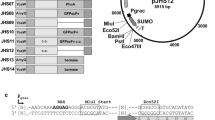Abstract
The gene encoding the α-amylase from Bacillus licheniformis was cloned, with and without the native signal sequence, and expressed in Escherichia coli, resulting in the production of the recombinant protein in the cytoplasm as insoluble but enzymatically active aggregates. Expression with a low concentration of the inducer at low temperature resulted in the production of the recombinant protein in soluble form in a significantly higher amount. The protein produced with signal sequence was exported to the extracellular medium, whereas there was no export of the protein produced from the gene without the signal sequence. Similarly, the α-amylase activity in the culture medium increased with time after induction in case of the protein produced with signal sequence. Molecular mass determinations by MALDI-TOF mass spectrometry and N-terminal amino acid sequencing of the purified recombinant α-amylase from the extracellular medium revealed that the native signal peptide was cleaved by E. coli signal peptidase between Ala28 and Ala29. It seems possible that the signal peptide of α-amylase from B. licheniformis can be used for the secretion of other recombinant proteins produced using the E. coli expression system.
Similar content being viewed by others
References
Park, C. S., Chang, C. C., Kim, J. Y., Ogrydziak, D. M., and Ryu, D. D. (1997) J. Biol. Chem., 272, 6876–6881.
Wang, L., Zhou, Q., Chen, H., Chu, Z., Lu, J., Zhang, Y., and Yang, S. (2007) J. Ind. Microbiol. Biotechnol., 34, 187–192.
Rashid, N., Cornista, J., Ezaki, S., Fukui, T., Atomi, H., and Imanaka, T. (2002) J. Bacteriol., 184, 777–784.
Jogensen, S., Vorgias, C. E., and Antranikian, G. (1997) J. Biol. Chem., 272, 16335–16342.
Marston, F. A. (1986) Biochem. J., 240, 1–12.
Thomas, J. G., and Baneyx, F. (1997) Protein Expres. Purif., 11, 289–296.
Hockney, R. C. (1994) Trends Biotechnol., 12, 456–463.
Rashid, N., Farooq, A., Haq, I., and Akhtar, M. (2009) Biologia, 64, 660–663.
Rashid, N., Ahmed, N., Haider, M. S., and Haque, I. (2010) Folia Microbiol., 55, 133–136.
Meens, J., Frings, E., Klose, M., and Freudl, R. (1993) Mol. Microbiol., 9, 847–855.
Simonen, M., and Palva, I. (1993) Microbiol. Rev., 57, 109–137.
Brockmeier, U., Caspers, M., Freudl, R., Jockwer, A., Noll, T., and Eggert, T. (2006) J. Mol. Biol., 362, 393–402.
Jalal, A., Rashid, N., Ahmed, N., Iftikhar, S., and Akhtar, M. (2011) Biochemistry (Moscow), 76, 347–349.
Laemmli, U. K (1970) Nature, 227, 680–685.
Shahhoseini, M., Ziaee, A. A., and Ghaemi, N. (2003) J. Appl. Microbiol., 95, 1250–1254.
Kuhn, H., Fietzek, P. P., and Lampen, J. O. (1982) J. Bacteriol., 149, 372–373.
Schallmey, M., Singh, A., and Ward, O. P. (2004) Can. J. Microbiol., 50, 1–17.
Li, P., Beckwith, J., and Inouye, H. (1988) Proc. Natl. Acad. Sci. USA, 85, 7685–7689.
Ikemura, H., Takagi, H., and Inouye, M. (1987) J. Biol. Chem., 262, 7859–7864.
Yamabhai, M., Emrat, S., Sukasem, S., Pesatcha, P., Jaruseranee, N., and Buranabanyat, B. (2008) J. Biotechnol., 133, 50–57.
Author information
Authors and Affiliations
Corresponding author
Additional information
Published in Russian in Biokhimiya, 2013, Vol. 78, No. 8, pp. 1215–1221.
Rights and permissions
About this article
Cite this article
Malik, B., Rashid, N., Ahmad, N. et al. Escherichia coli signal peptidase recognizes and cleaves the signal sequence of α-amylase originating from Bacillus licheniformis . Biochemistry Moscow 78, 958–962 (2013). https://doi.org/10.1134/S0006297913080142
Received:
Revised:
Published:
Issue Date:
DOI: https://doi.org/10.1134/S0006297913080142




